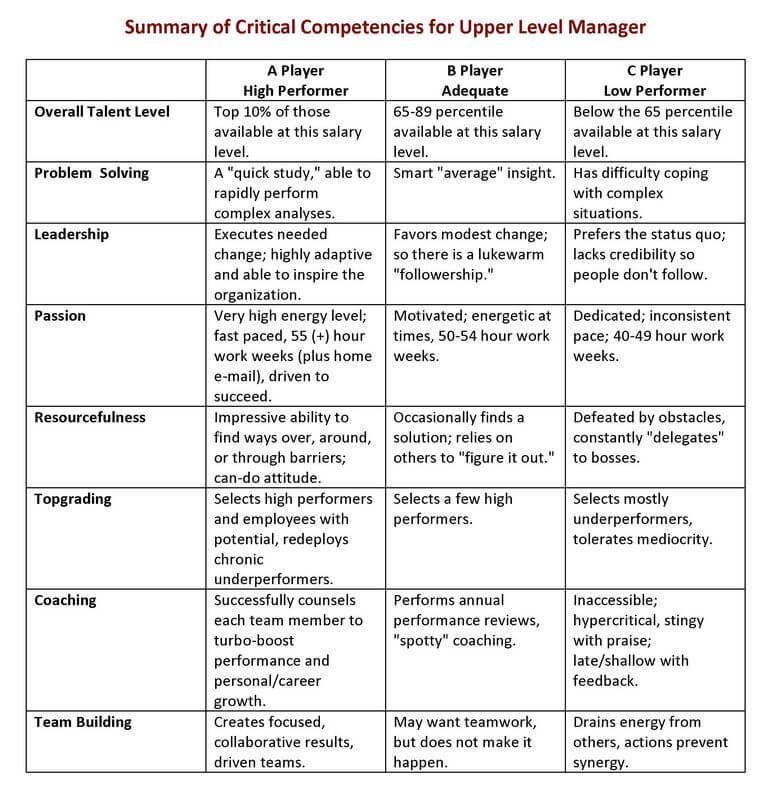(Editor’s Note: Last week at #TChat Events, the TalentCulture community explored best practices in candidate screening with Chris Mursau, Vice President at Topgrading, and Jean Lynn, VP of HR at Home Instead Senior Care. Afterward, some of our participants expressed interest in learning more about how the Topgrading method works. In response, Chris shared this post.)
Do you have difficulty determining if a job candidate (or existing employee) is an A, B, or C Player? If so, you’re not alone — only companies with highly sophisticated HR methods have perfected that process. However, this article helps by providing an explanation of how Topgrading experts evaluate current and prospective employees. These distinctions offer a measurable way to assess talent and build a winning team.
In many companies, “A Player” refers to someone highly promotable. Topgrading definitions of A, B, and C are different. “A, B, and C” grades refer to current ability, not promotability. However, Topgrading takes a deeper look within the A Player category to assess promotability. Here’s how:
A Player: The top 10% of talent available for a position. In other words, an A Player is among the best in class. “Available” means willing to accept a job offer:
• At the given compensation level
• With bonus and/or stock that corresponding to the position
• In that specific company, with a particular organization culture (e.g. Family friendly? Highly political? Fast paced? Topgraded and growing?)
• In that particular industry
• In that location
• With specific accountability levels and resources, and
• Reports to a specific person (e.g. Positive A Player or negative C Player?)
In other words, if you’re a terrific leader, many more candidates will be “available” to you than a lousy leader.
A Player Potential: Someone who is predicted to achieve A Player status, usually within 6-12 months.
B Player: The next 25% of available talent below the A Player top 10%, given the same A Player criteria listed above. These employees are “okay” or “adequate,” but they’re marginal performers who lack the potential to be high performers and are not as good as others available for the same pay. B Players are unable, despite training and coaching, to rise to A Player status. If they can qualify for a job as an A Player, they should be considered for it.
C Player: The next 35%, below the A Player 10% and B Player 25%, of talent available for a job. C Players are chronic underperformers.
The only acceptable categories are A Player and A Potential. We further categorize A Players by promotability:
A1: Someone who is promotable two levels
A2: Someone who is promotable one level
A3: Someone who is a high performer, but not promotable
Example: The not-promotable store stocker, sales rep, or first-level supervisor who is an A3, is a high performer, an A Player — but just not promotable. These employees are high performers because they achieve their A-Player accountabilities, plus they’re terrific with customers, they’re totally reliable, they achieve excellent results, they’re highly motivated, super honest, and very resourceful at finding ways to be more effective in driving the company mission.
It’s important to value all of your A Players, including the many who are the heart and soul of your company — including the A3s who are terrific, but are just not promotable.
How Do A, B and C Players Differ On Key Competencies?
The following chart is a bit simplistic, because not all A Players are this great on all competencies, and not all C Players are this bad on all competencies. Also note: for management jobs, Topgraders look at 50 competencies — this chart features only 8. However, it provides some insight into the methodology:

The Best Way to Identify As, Bs and Cs:
If you know the story of Topgrading, you know that this methodology has long been considered one the “secret weapons” Jack Welch used to improve General Electric’s success at picking A Players. In fact, the company’s success rate improved from 25% to well over 90%, using Topgrading to assess candidates for both hire and for promotion.
The methods are similar. Two trained interviewers conduct a tandem Topgrading Interview — and if there are internal candidates for promotion, rather than talking with outside references, the interviewers talk with bosses, peers and subordinates in the company.
It’s important to look for patterns of success. Bottom line, the “magic” of Topgrading comes from understanding how successful a person was in job 1, job 2, job 3, and so on, with the greatest weight given to the most recent jobs.
Summary: Extensive research shows that 75% of people hired or promoted turn out NOT to be A Players or A Potentials. Yet, Topgrading methods regularly achieve 80%+ success. For more real-world understanding of how this approach is applied, see case studies that demonstrate how companies improved from 26% to 85% on average, in hiring and promoting A Players.
Have you used Topgrading or other methods of assessing employee potential? What did you discover in your experience? Share your thoughts and questions in the comments area.
 (About the Author: Chris Mursau is Vice President of Topgrading, Inc. He has been practicing, teaching and consulting with companies and individual managers on how to pack their teams with A Players since 2001. He has conducted over 2,500 in-depth assessments for internal and external candidates, helped hundreds of people achiever their A potential, and trained thousands of people in all things Topgrading.)
(About the Author: Chris Mursau is Vice President of Topgrading, Inc. He has been practicing, teaching and consulting with companies and individual managers on how to pack their teams with A Players since 2001. He has conducted over 2,500 in-depth assessments for internal and external candidates, helped hundreds of people achiever their A potential, and trained thousands of people in all things Topgrading.)
(Also Note: To discuss World of Work topics like this with the TalentCulture community, join our online #TChat Events each Wednesday, from 6:30-8pm ET. Everyone is welcome at events, or join our ongoing Twitter and G+ conversation anytime. Learn more…)
Image Credit: Stock.xchng
Post Views: 1,299